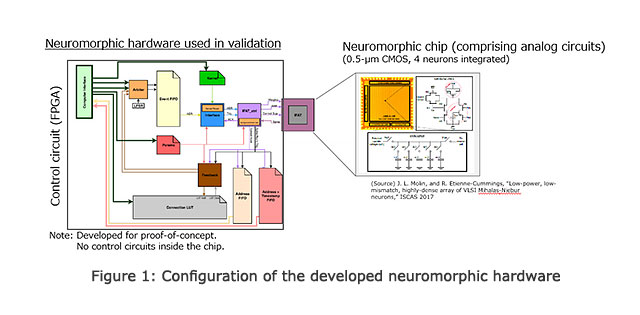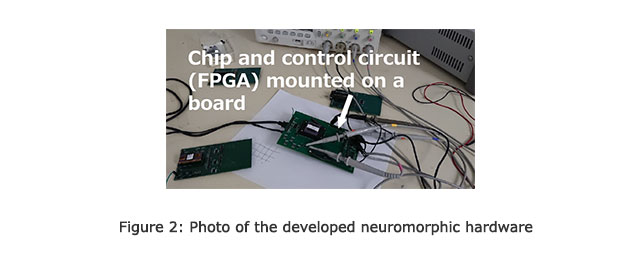Toshiba Succeeds in Mimicking Fundamental Function of Hippocampal Brain for Spatial Perception with Small Neuromorphic AI Hardware: Can be Implemented to Small Robots and Other Devices, Realizing Autonomous Locomotion Equipped with Spatial Perception Function
Toshiba Corporation
TOKYO─Toshiba Corporation (TOKYO: 6502), in a collaboration with Johns Hopkins University of the United States, has developed the world's first hardware implementation technique that mimics spatial perception, a fundamental function of the hippocampus, on a neuromorphic chip. This advance opens the way to miniaturizing autonomous mobile robots used in infrastructure inspection, where high spatial perception ability is required. Further advances in the research are expected to realize the mimicking and reproduction of more complex brain functions on small hardware, and the implement of highly intelligent AI technology in diverse fields.
Toshiba will announce the technology at the IEEE International Symposium on Circuits and Systems (ISCAS) at Sapporo, Japan, on May 29, 2019.
Neuromorphic information processing technology faithfully mimic neurons and the firing of synapses when information is transmitted in the brain, so partially mimicking brain functions, and neuromorphic hardware is any hardware equipped with such information processing technology. In this project, Toshiba and Johns Hopkins collaborated in developing a hardware implementation technique for mimicking spatial perception, a fundamental function of the hippocampus, with a rat as the subject, and in bringing to a neuromorphic chip. They verified approximately equivalent neural responses of the spatial perception function and developed the neuromorphic hardware.
Researchers worldwide are working to develop AI technology that can mimic the biological functions of the human brain on small devices, not least because it promises a breakthrough in miniaturizing industrial robots and disaster prevention robots. Brain inspired techniques are expected to offer a straightforward approach to fundamentally reducing the energy required for extremely large scale computation, to enable implementation of small, low-power devices. Also, as research in neuroscience advances and elucidates the inner workings of the brain, the research results can be applied to AI technology.
Current mainstream hardware for mimicking brain activity uses deep neural networks for digital signal processing. However, the brain does not digitally process the information it transmits─neurons process information in analog form through exchanges of electrical signals. Thus, faithfully mimicking brain functions such as spatial perception requires neuromorphic hardware that can mimic neuron activity in analog form. Until now, the required neuroscience expertise and hardware design skills have posed too high a hurdle to achieving this goal. However, in a joint research project combining expertise in neuroscience, physiology and engineering, Toshiba and Johns Hopkins have developed implementing technology for a neural circuit and controller that faithfully mimics a part of brain function. The neuromorphic chip was supplied by Johns Hopkins, and the mimicked brain activity is demonstrated with technology developed in combination with the neuromorphic chip.
In their research, Toshiba and Johns Hopkins focused on the rat hippocampus. Two of the most studied topics in neuroscience are the types of neurons in the hippocampus that control spatial recognition: place cells and grid cells(Note 1). In rats, a place cell fire only when the rat is in a particular place. Grid cells fire at multiple places which arranged in a periodic triangular array that covers the entire available environment. By applying its understanding of the neural network and previously published mathematical models, the research team developed the hardware configuration and control technology required to mimic a fundamental function of place cell and grid cell activity, and also technology to add noise to the neural firing signals with a Poisson distribution(Note 2). As a result, they successfully combined the neural hardware with control circuits as neuromorphic hardware (Fig. 1). In a demonstration, this neuromorphic hardware was able to reproduce the transmission of information by the firing of place cells, achieving nearly the same results as reported in neuroscience research.
No similar experimental results have been announced(Note 3). The results will accelerate research into mimicking brain activity, and are expected to contribute to realizing smaller autonomous mobile robots and other such devices. Going forward, Toshiba aims to continue advancing its research into making neuromorphic hardware even smaller, with the aim of further expanding the capabilities of AI as neuroscience progresses.


- (Note 1)
- John O'Keefe, 2014 Nobel Prize Winner in Physiology and Medicine: Discovery of place cells and grid cells in the hippocampus.
- (Note 2)
- A typical probability distribution for discrete random variables. The number of randomly occurring events during a certain interval of time or space is known to follow a Poisson distribution.
- (Note 3)
- As confirmed by Toshiba.


